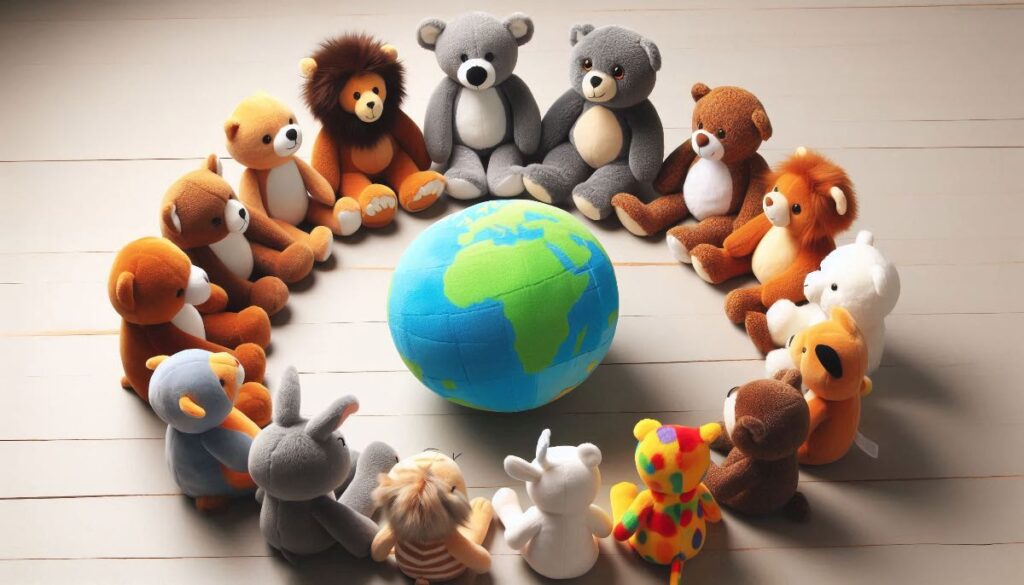Beauty and Fashion
The Enchanting Influence of Plush Toys: Exploring Their Impact on Society
Introduction – Why Plush Toys Matter More Than We Think
From the moment a child wraps their arms around a beloved teddy bear, something quiet but profound begins. That soft toy becomes more than fabric and stuffing — it becomes a companion, a secret-keeper, a symbol of comfort. For generations, plush toys have offered a safe place for imagination to bloom, for emotions to be expressed, and for memories to take root. But their role extends far beyond nursery shelves and childhood bedrooms. The true impact of plush toys is woven into the emotional, cultural, and even psychological fabric of society.
Plush toys support emotional development in children, offering a nonjudgmental presence during moments of fear, sadness, or uncertainty. In adulthood, they often resurface as nostalgic touchstones or meaningful collectibles — small reminders of a simpler, softer past. For neurodivergent individuals, plush toys can also provide sensory grounding and emotional regulation, proving that their benefits are not bound by age.
Beyond comfort, plush toys spark creative play. Whether reimagining a stuffed bunny as a brave explorer or assigning elaborate personalities to a group of soft animals, children use plush toys to build stories and simulate real-world interactions. This kind of play develops empathy, problem-solving skills, and narrative thinking — abilities that follow them into adult life.
Culturally, plush toys have taken on a life of their own. Entire communities form around collecting plush toys, trading limited editions, and sharing the joy of unique designs or characters with rich fictional worlds. Social media is full of plush-centric content, from aesthetic displays to travel photography featuring stuffed companions — testament to their evolving cultural significance.
In this article, we’ll explore the emotional benefits of plush toys, the rise of plush storytelling through unique backstories, and how modern design features continue to shape their role in everyday life. Whether you’re a lifelong collector, a curious parent, or simply someone who finds comfort in soft things, this journey will uncover the deeper value of the plush companions we so often take for granted.
Plush Toys with Backstories – When Characters Come to Life
In an age of mass production and fast consumption, storytelling has become one of the most powerful ways to forge emotional attachment — and plush toys are no exception. Plush toys with rich, imaginative backstories offer more than a cute appearance; they invite people to enter a small, personal universe. When a plush creature comes with a name, origin, or mythos, it ceases to be “just a toy” and begins to resemble a character — a companion with purpose (Gottschall 2012).
This narrative layering taps into a deeply human impulse: the need to connect with stories. Research shows that even very young children respond more strongly to toys with names and backstories than to anonymous objects, forming bonds that mirror early social-emotional development (Sobel and Brey 2014). These story-rich plush toys often serve as transitional objects — bridges between inner imagination and external reality (Winnicott 1953).
Collectors and enthusiasts have embraced this trend too. Brands like Jellycat, Steiff, and GUND increasingly release plush toys with lore — entire families of characters, written bios, and miniature storybooks that accompany each item. This enhances the emotional and monetary value of the toys, adding depth to the act of collecting plush toys.
Online, plush characters become protagonists in photo series, roleplay accounts, and storytelling challenges across social media platforms. These communities co-create new narratives, further entrenching the character-based identity of their plush companions (Gauntlett 2007).
By giving plush toys fictional lives, we’re also preserving their emotional relevance. These backstories are not just for children — they’re an answer to modern emotional needs: comfort, playfulness, and the desire for meaning in small things (Turkle 2011).
The Magic of Unique Features – Sensory Joy and Emotional Design
A plush toy’s charm often lies not just in its softness, but in the surprise of its details — a crinkle in the ears, a glow in the belly, a hidden message under a paw. These plush toys with unique features create multi-sensory experiences that make them more than comforting objects; they become emotionally responsive companions (Srinivasan and Bhat 2013).
For young children, these features aren’t just fun — they can support development. Tactile diversity (such as corduroy, silk, or fleece), sound elements (rattles, squeakers), or weighted bodies offer sensory regulation and emotional anchoring, especially for children with autism, anxiety, or sensory processing challenges (Case-Smith and Arbesman 2008). The right texture at the right time can calm the nervous system or re-engage attention during play.
Even in neurotypical development, toys with interactive features encourage creativity. A plush owl that “hoots” when hugged or a fox with reversible colors invites storytelling. Children don’t just cuddle these toys — they assign them roles, invent challenges, and bring them into fantasy worlds. This supports imaginative and social-emotional learning, building narrative thinking and empathy through play (Piaget 1951).
Adults aren’t immune to these effects. Many find that toys with nostalgic or unique qualities — perhaps a sound reminiscent of childhood, or a scent-infused fabric — offer a sense of calm and joy. This links to the concept of affective nostalgia, where sensory experiences bring back emotionally charged memories (Wildschut et al. 2006).
Whether used therapeutically or playfully, plush toys with thoughtfully integrated features go beyond novelty. They transform routine interactions into rituals of care and comfort. A squeaky paw or stitched-on message can become a child’s security anchor — or an adult’s pocket-sized reminder that softness still has a place in grown-up life (Turkle 2011).
Collecting as Connection – The Plush Toy Community and Identity
What begins as childhood affection often evolves into a lifelong habit: collecting. For many, collecting plush toys is not just about acquisition — it’s a form of self-expression, nostalgia, and community-building. Across social media, conventions, and online marketplaces, collectors of all ages connect over shared appreciation for softness, design, and meaning (Belk 1988).
Unlike other collectibles, plush toys blur the line between object and companion. People give them names, display them in curated environments, or take them on trips and photograph their adventures. In doing so, they form bonds with the toy — and with others who understand that emotional investment. These behaviors reinforce identity and belonging, particularly in digital spaces where plush lovers trade stories, tips, and character “lore” (Turkle 2011).
Collecting also allows adults to reconnect with play and emotional vulnerability. Studies suggest that objects associated with childhood can act as anchors for emotional stability in adulthood, especially during times of stress or change (Routledge et al. 2011). For some, a plush collection isn’t just a hobby — it’s a sanctuary.
Whether proudly displayed or privately cherished, these collections speak to something deep: the universal human need to touch, remember, and belong.
Conclusion – The Lasting Influence of Plush Toys
The impact of plush toys reaches far beyond the toybox. These soft companions shape childhoods, support emotional regulation, inspire storytelling, and forge social identity. They are more than objects of affection — they are objects of meaning. Whether stitched by hand or factory-made, infused with backstories or designed for sensory delight, plush toys endure because they meet one of our oldest needs: the need for comfort with character (Winnicott 1953).
In early development, plush toys act as emotional surrogates — transitional objects that allow children to navigate the space between dependence and independence. They offer a tactile bridge between inner feelings and external expression. For adults, plush toys return in quieter but no less powerful ways: as collectibles, keepsakes, therapeutic tools, or symbols of selfhood in a fast-moving world.
And in every phase of life, their influence is tied to softness — not just as a texture, but as a philosophy. Plush toys remind us that affection doesn’t have to be grand to be profound, and that even in our most advanced, digital realities, something as simple as a stuffed bear can carry weight and worth (Turkle 2011).
As we continue to shape the future of toys, let us not forget the quiet magic of the plush. They’re never just cute. They’re vessels for memory, imagination, and the small, soft forms of love that shape us all.
References
Belk, R. W. (1988). “Possessions and the Extended Self.” Journal of Consumer Research, 15(2), 139–168.
Case-Smith, J., & Arbesman, M. (2008). “Evidence-Based Review of Interventions for Autism Used in or of Relevance to Occupational Therapy.” American Journal of Occupational Therapy, 62(4), 416–429.
Gauntlett, D. (2007). Creative Explorations: New Approaches to Identities and Audiences. London: Routledge.
Gottschall, J. (2012). The Storytelling Animal: How Stories Make Us Human. Boston: Houghton Mifflin Harcourt.
Piaget, J. (1951). Play, Dreams and Imitation in Childhood. New York: Norton.
Routledge, C., Arndt, J., Sedikides, C., & Wildschut, T. (2011). “A Blast From the Past: The Terror Management Function of Nostalgia.” Journal of Experimental Social Psychology, 47(1), 132–140.
Sobel, D. M., & Brey, E. (2014). “Children infer from the descriptions of objects that they were created with intention.” Developmental Psychology, 50(7), 1563–1570.
Srinivasan, S. M., & Bhat, A. N. (2013). “A Review of ‘Sensory’ Interventions for Individuals with Autism Spectrum Disorders.” Journal of Autism and Developmental Disorders, 43(4), 853–870.
Turkle, S. (2011). Alone Together: Why We Expect More from Technology and Less from Each Other. New York: Basic Books.
Wildschut, T., Sedikides, C., Arndt, J., & Routledge, C. (2006). “Nostalgia: Content, Triggers, Functions.” Journal of Personality and Social Psychology, 91(5), 975–993.
Winnicott, D. W. (1953). “Transitional Objects and Transitional Phenomena.” International Journal of Psycho-Analysis, 34, 89–97.


